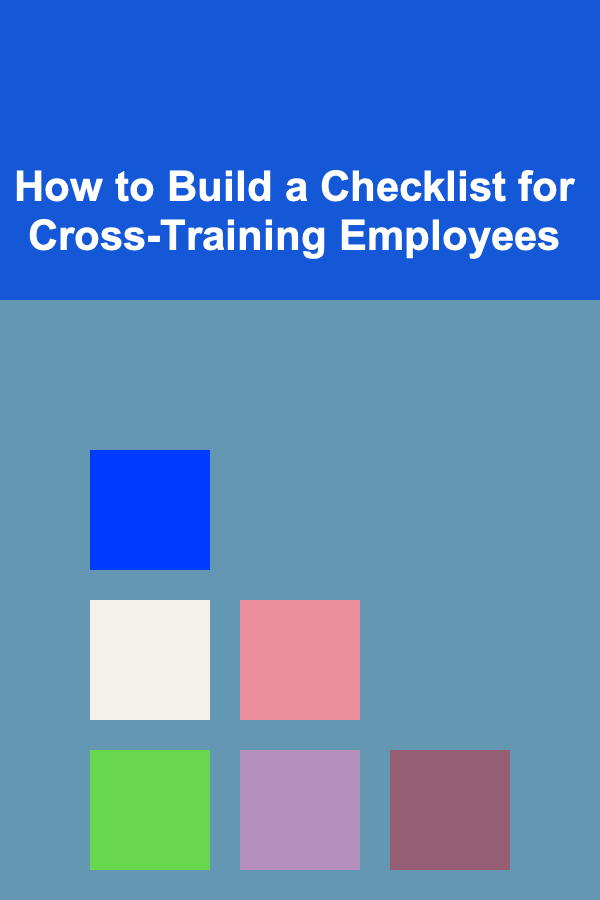
How to Build a Checklist for Cross-Training Employees
ebook include PDF & Audio bundle (Micro Guide)
$12.99$6.99
Limited Time Offer! Order within the next:

Cross-training employees is a powerful strategy that helps businesses create a more agile workforce, improve efficiency, and reduce dependency on specific individuals. By ensuring that employees are trained in multiple roles, companies can mitigate risks like turnover, absenteeism, or sudden changes in staffing needs. Creating a well-structured checklist for cross-training employees is essential to ensure that the process is both effective and sustainable. This actionable guide will take you through the steps to build an efficient cross-training checklist that maximizes your organization's potential.
Define the Purpose of Cross-Training
Before diving into the specifics of creating a checklist, it's crucial to understand the goals of cross-training. A checklist is only effective if it aligns with the overall objectives of the training initiative. Clearly define why cross-training is necessary for your organization.
Key Goals of Cross-Training:
- Increase Flexibility: Employees who can perform multiple roles are more adaptable to sudden changes in workload or unexpected absences.
- Enhance Collaboration: When employees are trained in different areas, they gain a better understanding of the challenges and responsibilities of their colleagues, fostering teamwork.
- Improve Skill Development: Cross-training helps employees develop new skills, which can lead to greater job satisfaction and career growth.
- Reduce Single Point of Failure: Relying on one person to complete a critical task can be risky. Cross-training ensures that others can step in when necessary, reducing the impact of turnover or absence.
By establishing clear goals, you'll ensure that your cross-training efforts are focused and aligned with organizational needs.
Identify the Roles to Be Cross-Training
Not every role in the organization needs to be cross-trained. Start by identifying which positions or functions would benefit most from cross-training. These could be positions that are highly interdependent, require specialized knowledge, or are critical to the organization's operations.
Considerations for Role Selection:
- Critical Functions: Identify positions that are essential to daily operations. If someone in these roles were to be absent or leave, it could significantly impact the business.
- Complementary Roles: Focus on roles that work closely together. For example, cross-training between a sales and marketing team or between customer support and technical teams can improve efficiency and reduce misunderstandings.
- Job Complexity: Consider the complexity of the roles. Cross-training for simpler roles can be faster, while more complex roles may require a longer, more in-depth training plan.
- Current Gaps: Look for areas where current knowledge or staffing gaps exist. If certain tasks are only performed by one or two people, that's a sign to consider cross-training for those roles.
By choosing the right roles, you can ensure that cross-training provides maximum value to the business.
Determine the Key Skills and Knowledge Areas for Each Role
Once the roles have been identified, break down each role into its core tasks, skills, and responsibilities. This step is critical, as it ensures the cross-training covers the most essential aspects of each role.
Key Areas to Include:
- Technical Skills: What technical expertise is needed for the role? For instance, if the role involves using specific software or systems, ensure that employees are trained in those tools.
- Soft Skills: Some roles require a set of interpersonal or communication skills. For instance, a customer service representative might need to handle difficult customers with patience and empathy.
- Procedures and Protocols: Every role has specific workflows, processes, and protocols. For example, if an employee in an operations role is being cross-trained for a management position, they should learn how to handle scheduling, decision-making, and employee management.
- Problem-Solving Skills: Many roles require employees to think on their feet and solve problems in real-time. Include scenarios in the training that help employees develop these skills.
- Cultural and Organizational Knowledge: Employees must also be trained in the company's culture and values, which often play a crucial part in effective role performance.
By outlining the key skills and knowledge areas for each role, you can ensure that the training is both comprehensive and relevant.
Develop a Step-by-Step Training Plan
A clear and structured training plan is the backbone of your cross-training checklist. Break down the training into manageable steps that employees can follow, and ensure that each step focuses on a key competency or skill.
Components of a Step-by-Step Plan:
- Introduction and Overview: Start with an introduction to the role. Explain the significance of the role within the organization, its responsibilities, and how it fits into the bigger picture.
- Job Shadowing: Allow employees to shadow someone in the role they're being trained for. This provides hands-on experience and a real-world understanding of the tasks.
- Hands-On Training: After shadowing, provide opportunities for employees to perform tasks under supervision. This could involve taking on small portions of the work or performing specific tasks while being guided by the trainer.
- Documentation and Procedures: Provide access to any documentation, standard operating procedures (SOPs), or checklists related to the role. This ensures employees can refer to resources as needed.
- Mentorship and Feedback: Pair the employee with a mentor who can answer questions, provide guidance, and give constructive feedback.
- Performance Evaluation: After the training period, assess the employee's performance in the role to identify any areas for improvement.
By following a structured plan, you ensure that employees receive a well-rounded and thorough cross-training experience.
Create the Cross-Training Checklist
Now that the roles, key skills, and training plan have been defined, it's time to create the actual checklist. The checklist should be a simple, actionable tool that guides employees through the cross-training process. It should be broken down into clear tasks and milestones, ensuring that nothing is overlooked.
Checklist Structure:
- Role Overview: Provide a summary of the role and its significance within the organization.
- Skills and Knowledge Areas: List the key skills, tools, and processes required for the role.
- Step-by-Step Training Tasks : Break down the training process into sequential tasks. Each task should be specific and measurable. For example:
- Task 1: Learn how to use [Software Name].
- Task 2: Shadow a senior employee for one week.
- Task 3: Complete a mock project or task under supervision.
- Task 4: Review and familiarize yourself with [Documentation Name].
- Progress Milestones: Identify milestones that indicate the employee is progressing in their training. These could be dates, tasks completed, or assessments passed.
- Assessment and Evaluation: After training, the checklist should include a final review section to assess how well the employee has learned the new role.
Ensure that the checklist is easily accessible and can be updated as necessary. It should be a dynamic tool that helps guide the employee through the training process.
Implement and Monitor the Training Process
With the checklist in hand, you can begin implementing the cross-training program. Start by assigning employees to the roles they will be trained for and monitor their progress throughout the process. Regular check-ins with employees and trainers are essential to ensure that training is effective and that employees are retaining the information.
Monitoring and Adjusting:
- Track Progress: Use the checklist as a tracking tool to ensure that all necessary training steps are completed. Regularly check in with employees to gauge their comfort level with the new role.
- Address Challenges: Some employees may find certain tasks more difficult than others. Provide additional training or resources as needed to help them succeed.
- Adjust the Checklist: Based on feedback from employees and trainers, you may find that certain areas of the checklist need to be revised or enhanced. Continually refine the process to ensure it remains relevant and effective.
Evaluate the Results and Refine the Process
Once the cross-training is completed, evaluate the effectiveness of the program. Did the employees perform well in their new roles? Did the cross-training reduce inefficiencies, improve flexibility, or increase collaboration? Collect feedback from employees and managers to understand what worked well and where improvements can be made.
Post-Training Evaluation:
- Feedback from Employees: Gather feedback from employees about their experience with the cross-training process. Were they adequately prepared for the role? Did they feel supported?
- Performance Assessment: Assess how well the cross-trained employees are performing in their new roles. Have they been able to contribute to the team in a meaningful way?
- Review and Refine: Based on the feedback and performance assessments, refine the checklist and training process for future use.
Conclusion
Building a checklist for cross-training employees is a step-by-step process that requires careful planning, clear goals, and continuous feedback. By defining the purpose, identifying key roles, developing a training plan, and creating a structured checklist, you can ensure that your employees are equipped to handle multiple roles, thereby increasing flexibility and productivity within your organization. Moreover, by monitoring the process and evaluating the results, you can continually improve the cross-training program to keep it effective and aligned with your business goals.

How to Create a Festive Holiday Vibe with Minimal Decorations
Read More
How to Keep Your Pet's Bed Clean and Cozy
Read More
How to Optimize Under-Bed Storage for Extra Space
Read More
How to Use Labeling for Shared Kitchen Items
Read More
Mastering Technical Support: Best Practices for Engineers in the Tech Industry
Read More
Remote Job Searching: Strategies for Introverts
Read MoreOther Products

How to Create a Festive Holiday Vibe with Minimal Decorations
Read More
How to Keep Your Pet's Bed Clean and Cozy
Read More
How to Optimize Under-Bed Storage for Extra Space
Read More
How to Use Labeling for Shared Kitchen Items
Read More
Mastering Technical Support: Best Practices for Engineers in the Tech Industry
Read More